
Electronic english version since 2022 |
The newspaper was founded in November 1957
| |
Conferences
Current problems and new technologies in the foreground
From October 25 to 27, the JINR International Conference Centre hosted the Conference "Current Problems in Radiation Biology. To the 60th Anniversary of the Scientific Council on Radiobiology of the Russian Academy of Sciences". Within the framework of the Conference, a Plenum of the Scientific Council on Radiobiology of the Russian Academy of Sciences was held. Its participants recalled prominent Soviet radiobiologists, radioecologists, founders of space medicine, a meeting of the Board of the Radiobiological Society of the Russian Academy of Sciences was held.
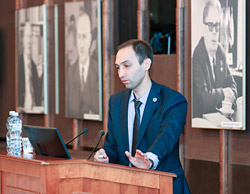 Before the opening of the scientific part of the Conference, LRB Director A.N.Bugay spoke about its tasks to the media representatives of the Joint Institute:
Before the opening of the scientific part of the Conference, LRB Director A.N.Bugay spoke about its tasks to the media representatives of the Joint Institute:
- Today, there will be delivered reports on key issues of modern radiobiology, ranging from experimental problems to the most important practical applications: on space topics, space medicine, tasks related to the development of novel radioprotectors, problems of radiation therapy and its applications. In addition, a special section on mathematical modeling is scheduled, where modern approaches will be presented, we will not bypass such an important problem as non-ionizing radiation. The Conference is attended by specialists from academic institutions and clinical centres in Moscow, Obninsk, Pushchino, Sarov and colleagues from Chelyabinsk, Tomsk and other cities will be in contact with us.
At present, LRB widely develops. At JINR, there is an area of developing life sciences and our laboratory is a leader here. Our most important position is probably the radiobiology of heavy ions and the most significant applications related to it, such as the radiation safety of space flights and the use of hadron beams in radiation therapy. In addition, we are involved in such related tasks as improving the efficiency of conventional radiation therapy using photon beams, problems of neurophysiology, closely related to the study of the brain - these are very important, topical issues. Of course, we do not bypass the fundamental areas concerning the molecular mechanisms of the action of radiation on matter, with the development of molecular radiobiology, genetics and neurochemistry. The laboratory is gradually replenished with new equipment, we have recently put into operation a new, precision facility for irradiating animals. In fact, these are technologies that allow the development of radiation therapy: by simulating it on animals, to successfully carry out internationally certified preclinical research. In this sense, we will gradually develop, implement educational programmes and attract young people that are passionate about life sciences.
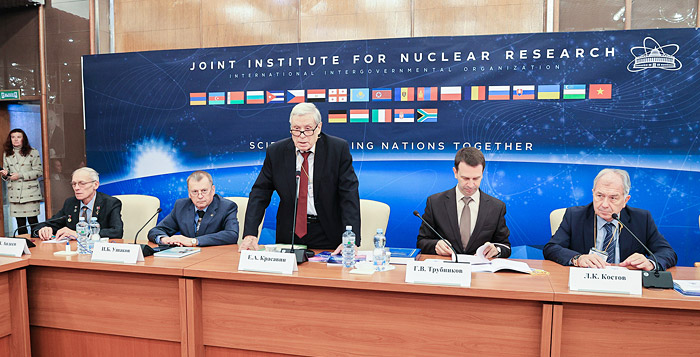
Yesterday, a meeting of the Plenum and the Council on Radiobiology of the Russian Academy of Sciences was held, some issues of the radiobiological society were discussed. The Society and the Council were replenished with new members - both young people and honored ones. So, our science gradually takes on new outlines and we confidently look into the future.
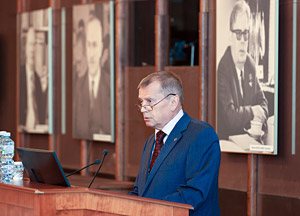 Academician of the Russian Academy of Sciences I.B.Ushakov (Burnasyan Federal Medical Biophysical Center of Federal Medical Biological Agency) opened the scientific programme of the Conference with the report "Space radiation: 60 years at the epicenter of research of the Scientific Council on Radiobiology of the Russian Academy of Sciences". He started with the history of space radiobiology and ended his speech as follows: "We are on the verge of human exploration of new celestial bodies and planets. We need a new concept of radiation protection in space."
Academician of the Russian Academy of Sciences I.B.Ushakov (Burnasyan Federal Medical Biophysical Center of Federal Medical Biological Agency) opened the scientific programme of the Conference with the report "Space radiation: 60 years at the epicenter of research of the Scientific Council on Radiobiology of the Russian Academy of Sciences". He started with the history of space radiobiology and ended his speech as follows: "We are on the verge of human exploration of new celestial bodies and planets. We need a new concept of radiation protection in space."
Answering a question about the relationship between results and plans, Igor Borisovich said:
- There are much more plans than results, the results have been published, including, in a six-volume Russian-American proceedings on space medicine. And there are a lot of plans that everyone in the world would like to carry out, but the implementation of space activities, unfortunately, depends on financial conditions and many space programmes are postponed for reasons beyond anyone's control. One can only complain about this, but many things have to be carried out on Earth, in simualting conditions. And model-based analysis is very limited and cosmic radiation can only be simulated on its constituent parts. And piece by piece to put together the picture of radiation changes in various human organs and systems that can occur during irradiation in flight conditions. This is a forced path, it has its limitations and its mistakes, I tried to tell about this in my report.
- But there is no other way...
- There is no other way. It can and should be simulated in biological experiments on satellites. There was a wonderful programme "Bion" (a series of Soviet and Russian spacecraft designed for biological research - hereinafter the author's notes). This year, on 4 October, we celebrated the 65th anniversary of the beginning of the space age, yet somehow we forgot about another anniversary that is perhaps more significant from the point of view of biology, medicine and manned astronautics - this is the flight of the second artificial satellite with the dog Laika on board. The 65th anniversary of this flight is celebrated on 3 November when the first living being from Earth was launched. Issues of radiation safety were estimated, however, using calculation methods. The first radiobiological group was established at the Institute of Aviation and Space Medicine (then the Institute of Aviation Medicine) in 1958, formally after Laika's flight. And for the flight of Yu.A.Gagarin, they started to prepare in advance. In 1958, a radiobiological group was organized, headed by A.A.Gyurjian. Little is known about him, although his photograph with Belka and Strelka, whom he prepared for flight in 1960, went around the world. Then, with the help of calculations and indirect estimates, the possible radiation dose was determined. And Gagarin already had a dosimeter, designed by Professor I.B.Keirim-Markus with his students at the Institute of Biophysics. We have recently celebrated the 100th anniversary of this unique scientist. He has a big School, he wrote several monographs.
So, Laika's flight was actually the first experiment of the Bion programme, followed by launches of devices with mice, rats and even monkeys. The last flight took place at the end of 1996. In this century, the programme proceeded in 2013 with the launch of the Bion-M apparatus number 1 with mice, microbes, seeds. It was a very productive flight rich in scientific results. At present, the flight of the Bion-M apparatus number 2 is scheduled. For technical reasons, it has already been postponed several times; today, the launch is scheduled for 2024. The last flight of the non-biological satellite "Photon-M" number 4 with microbes and seeds took place in 2014. This is a very promising area for estimation, including radiosensitivity, a very efficient way of direct, real simulation of cosmic radiation in flight.
There are plans to launch satellites into higher orbits, up to 20000 km, where radiation doses are much higher. This is already interplanetary space, there is harder radiation, there are heavy charged particles, that is, the conditions are close to those interplanetary flights that we think about.
Of course, before Gagarin's flight, there were skeptics who believed that radiation doses would be higher, but the truth turned out to be on the side of the optimists. Gagarin's flight and subsequent flights with radiation measurements on board the station showed that at these doses one can fly for a sufficiently long time and radiation during orbital flights is not a serious obstacle. Weightlessness is still a much greater barrier. And in interplanetary flights, radiation can come to the fore, although weightlessness will still be a serious barrier. Here, the joint efforts of the Institute of Biomedical Problems, Burnasyan Federal Medical Biophysical Center and Gagarin Research&Test Cosmonaut Training Center" are required. We need a medical-dosimetric register of cosmonauts, constantly updated, with detailed health passports, accessible to specialists. Such a register was compiled for Chernobyl victims, Rosatom maintains its own register, but there is none for astronauts. I hope, it will be established under the Federal Medical and Biological Agency that has the appropriate skills and the latest developments to establish such registers in various fields of human activity.
- Are there any prospects?
- There are prospects. If the register establishes, it will become the basis for further progress, including for the preparation of interplanetary flights. It is necessary to move in sequence: first to fly to the Moon, then to Mars - in such a sequence it will be most correct even from the point of view of human training.
- Is Elon Musk's Mars project a chimera?
- No, Musk is certainly a smart person, an ascetic of space, I would not like to talk about commercial reasons here. He loves space, looks ahead. I respect this person. We need to take the best of what opponents from other countries offer and develop in Russia, not to depend on other space programmes. The scheduled Russian orbital station ROSS is an extremely necessary task in which representatives of all organizations should participate, including, in the aspect of radiation protection. The position of LRB JINR, whose staff members gave excellent reports here and tirelessly improve the experimental base, commands respect. We should support each other as we move from model experiments to onboard development.
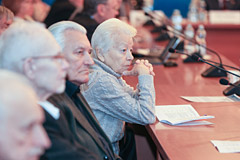
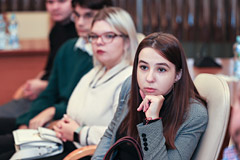
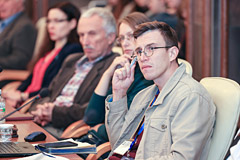
(Ending in next issues)
Olga TARANTINA,
photo by Igor LAPENKO